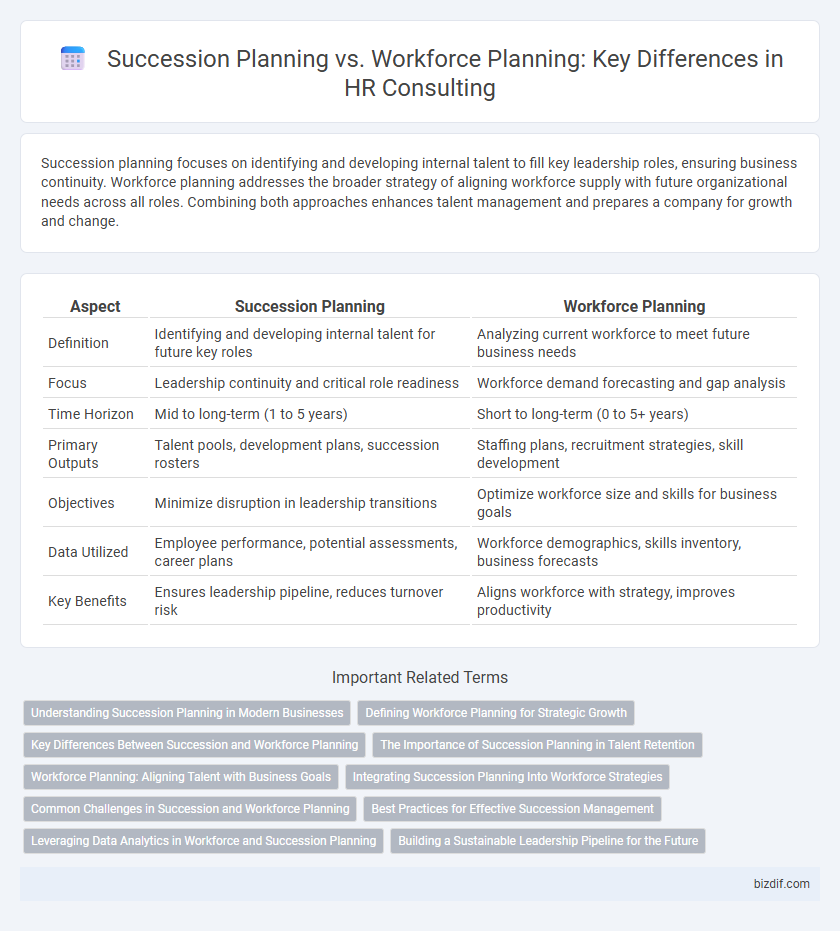Succession planning focuses on identifying and developing internal talent to fill key leadership roles, ensuring business continuity. Workforce planning addresses the broader strategy of aligning workforce supply with future organizational needs across all roles. Combining both approaches enhances talent management and prepares a company for growth and change.
Table of Comparison
| Aspect | Succession Planning | Workforce Planning |
|---|---|---|
| Definition | Identifying and developing internal talent for future key roles | Analyzing current workforce to meet future business needs |
| Focus | Leadership continuity and critical role readiness | Workforce demand forecasting and gap analysis |
| Time Horizon | Mid to long-term (1 to 5 years) | Short to long-term (0 to 5+ years) |
| Primary Outputs | Talent pools, development plans, succession rosters | Staffing plans, recruitment strategies, skill development |
| Objectives | Minimize disruption in leadership transitions | Optimize workforce size and skills for business goals |
| Data Utilized | Employee performance, potential assessments, career plans | Workforce demographics, skills inventory, business forecasts |
| Key Benefits | Ensures leadership pipeline, reduces turnover risk | Aligns workforce with strategy, improves productivity |
Understanding Succession Planning in Modern Businesses
Succession planning in modern businesses involves identifying and developing internal talent to ensure leadership continuity and minimize disruption during critical transitions. It requires a strategic approach to assess key roles, evaluate potential successors, and implement targeted training programs that align with long-term organizational goals. Effective succession planning strengthens workforce resilience and drives sustainable growth by preparing future leaders well in advance.
Defining Workforce Planning for Strategic Growth
Workforce planning for strategic growth involves analyzing current talent capabilities and forecasting future workforce needs to align with an organization's long-term goals. This process prioritizes identifying skill gaps, optimizing headcount, and ensuring the right people are in the right roles to drive business outcomes. Effective workforce planning integrates market trends, technology advancements, and demographic data to build a flexible and resilient talent strategy.
Key Differences Between Succession and Workforce Planning
Succession planning focuses on identifying and developing internal talent to fill critical leadership roles, ensuring business continuity in key positions. Workforce planning involves analyzing current and future workforce needs across all levels, aligning talent acquisition and development strategies with organizational goals. The key difference lies in succession planning's targeted approach to leadership readiness versus workforce planning's broader scope for overall talent management.
The Importance of Succession Planning in Talent Retention
Succession planning plays a critical role in talent retention by identifying and preparing high-potential employees for future leadership roles, which fosters employee engagement and loyalty. Unlike workforce planning, which focuses on aligning current workforce capacity with organizational needs, succession planning strategically develops internal talent to ensure continuity and reduce turnover. Organizations that invest in succession planning experience higher retention rates and a stronger leadership pipeline, essential for sustainable growth and competitive advantage.
Workforce Planning: Aligning Talent with Business Goals
Workforce planning strategically forecasts talent needs to align employee capabilities with evolving business goals, ensuring optimal resource allocation. It integrates data analytics and market trends to proactively address skill gaps and workforce demands, enhancing organizational agility. Effective workforce planning supports succession planning by providing a comprehensive talent pipeline aligned with long-term business objectives.
Integrating Succession Planning Into Workforce Strategies
Integrating succession planning into workforce strategies ensures organizations maintain leadership continuity and align talent development with long-term business goals. By embedding succession plans within broader workforce planning, companies can proactively identify critical roles and prepare high-potential employees for future leadership positions. This strategic alignment enhances organizational agility, reduces risks associated with key talent gaps, and supports sustainable growth.
Common Challenges in Succession and Workforce Planning
Succession planning and workforce planning both face common challenges such as identifying critical roles and developing internal talent pipelines to ensure business continuity. Limited data accuracy and forecasting capabilities often hinder the alignment of future workforce needs with strategic goals. Resistance to change and lack of leadership commitment can further impede the effective implementation of these planning processes.
Best Practices for Effective Succession Management
Effective succession management integrates detailed succession planning with comprehensive workforce planning to ensure leadership continuity and talent readiness. Best practices include identifying critical roles, developing internal talent through targeted training programs, and regularly updating talent pipelines based on organizational growth and changing market demands. Leveraging data analytics and employee performance metrics enhances decision-making, aligning succession strategies with overall business objectives.
Leveraging Data Analytics in Workforce and Succession Planning
Leveraging data analytics in workforce and succession planning enhances decision-making by identifying skill gaps, forecasting talent needs, and optimizing talent pipelines. Advanced analytics enable HR professionals to assess employee performance, predict turnover risks, and align workforce capabilities with strategic business goals. Integrating predictive models and real-time data insights ensures a dynamic and agile approach to both succession readiness and workforce optimization.
Building a Sustainable Leadership Pipeline for the Future
Succession planning targets identifying and developing internal candidates for key leadership roles, ensuring continuity and minimizing disruption during transitions. Workforce planning involves analyzing current workforce capabilities and future needs to align talent acquisition, development, and retention strategies. Integrating these approaches builds a sustainable leadership pipeline, fostering organizational resilience and long-term growth.
Succession Planning vs Workforce Planning Infographic

 bizdif.com
bizdif.com